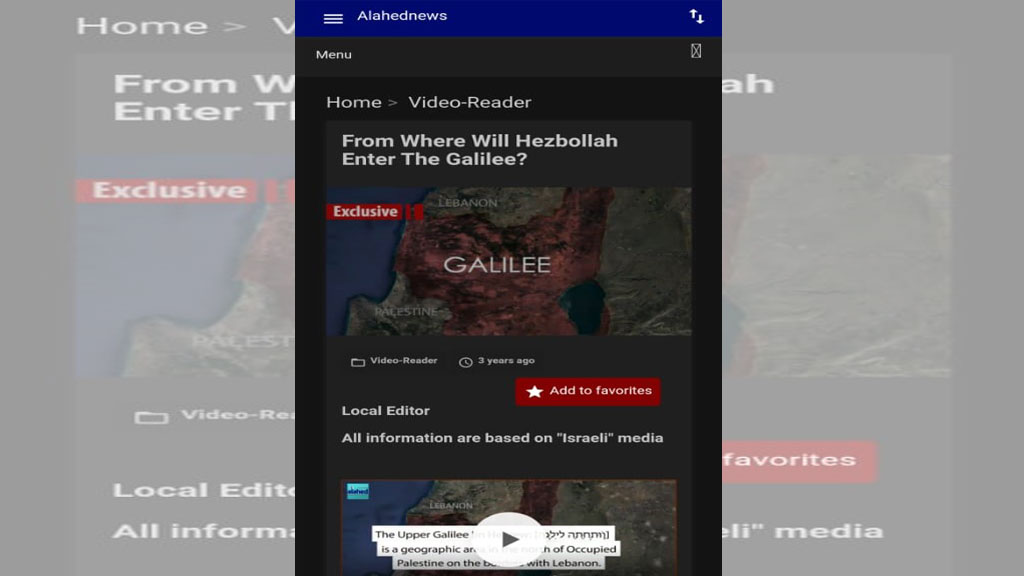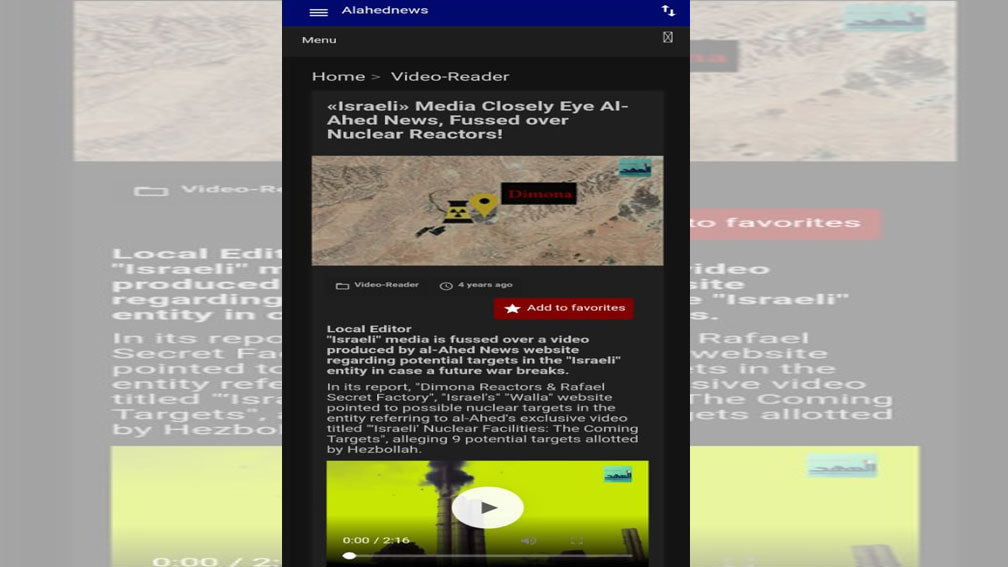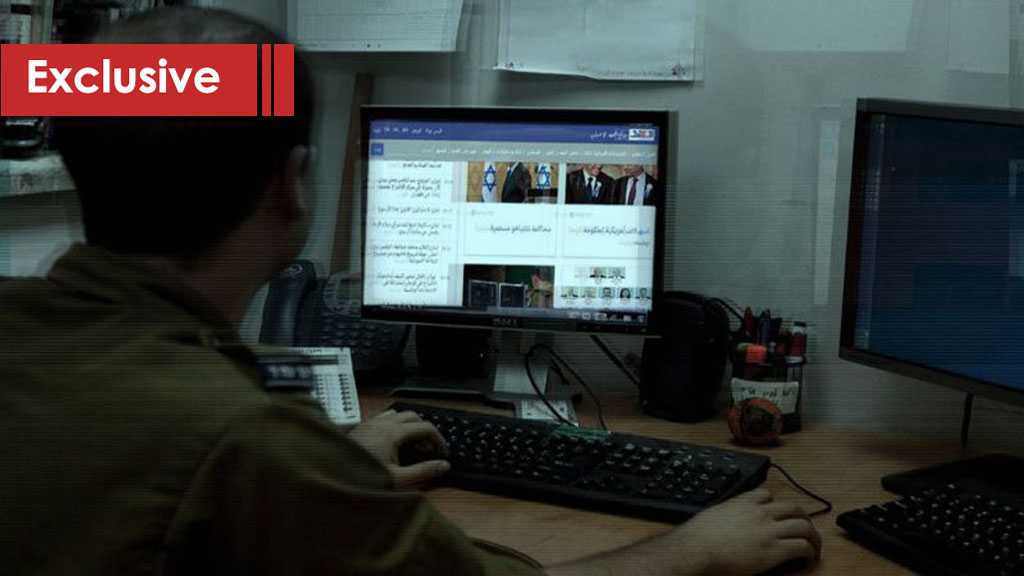“Israel’s” battle with Hezbollah goes back many years. Throughout that time, the “Israelis” experienced the group’s methods of warfare, and perhaps thought they understood it all. But little by little, it turned out that this simply wasn’t the case. The enemy is fully aware that from the time when the first shots were fired, the resistance caught them by surprise, both in the media and on the battlefield. Everything was different in Lebanon. “Israel” never encountered these methods with previous movements.
The war media of the resistance posed a challenge to the “Israelis”. They tried to decipher its codes, but each time they were disappointed. With the launch of the resistance intelligence in 1983, shortly after the establishment of Hezbollah, the Zionists became acquainted with a new media that reported on confrontations and heroism. Then there was the radio station to broadcast the voice of the oppressed, followed by Al-Ahed newspaper and successively other media outlets. The years of fighting were abundant with pivotal stages, but the enemy never forgot one of them, which may be the most painful.
Ansariya ambush and its psychological warfare
The Ansariya operation took place in 1997. The tactics behind this operation were completely different from its predecessors. The objective, the method, and the results left deep scars on the enemy.
The “Israelis” were desperate to put a lid on this scandal, calamity, and defeat. The ambush that led to the “annihilation” of 12 officers and soldiers from the “Israeli” Shayetet unit broke generalizations about the enemy’s military oversight. At that stage, the Zionists tried to prevent the news from reaching the settlers. But the Islamic Resistance Support Association, through the Internet division that had been launched during this period, pierced the “Israeli” censorship. Through the successful use of material related to the remains of the soldiers, it was able to stir internal “Israeli” controversy and confirm the growing mistrust between the military establishment and society at large.
The Association’s success quickly appeared in the enemy’s media. In November 1998, the Haaretz newspaper reported that some families of the dead soldiers killed in Ansariya demanded the formation of an investigation committee to look into the conditions of their relatives’ burial, after some families felt that the shape of their children’s graves had changed without informing them of the circumstances of the secret burial.
But the story does not end here. Through its online division, the Support Association prepared a detailed statement addressing the families of the dead, including information and pictures that were published for the first time, along with a set of questions about the truth regarding the remains of the “Israeli” soldier, Elia Itamar, in an attempt to cement the divide between the “Israeli” army and the families of the soldiers.
The material published by the Support Association led to the sowing of doubts in the hearts of the families, who at the time expressed their lack of trust in their army. Nhatson Tabbi, the father of one of the dead officers (Raz Tabbi), said in an interview with Army Radio at the time: “I trust Hezbollah more than my government.”
Maariv and the Jerusalem Post newspapers also highlighted the magnitude of the Support Association’s online move, with both circulating statements of the families of the dead soldiers based on what was published through Hezbollah’s electronic media. The issue of the remains dominated headlines for a while until an additional committee was formed to investigate the botched operation, following the rift between the families of the soldiers and the occupation army.
Accordingly, the Ansariyah operation established Hezbollah’s media weapon as an influential tool that is monitored and feared.
The impact of the resistance’s electronic media
The subsequent years of confrontation also received media attention from the occupation. With the advancement and development of technologies, the resistance’s online networks gained momentum. Parallel to the speeches of the Secretary-General of Hezbollah, Sayyed Hassan Nasrallah, and the equations that it drew on the level of the struggle with the enemy, the electronic media of the Islamic Resistance stepped up its own strikes against the enemy.
In 2012, Sayyed Nasrallah, for the second time, labeled the Galilee as the inevitable setting for ground resistance operations in the event that “Israel” attacked Lebanon. At that time, the Al-Intiqad website published a map of a virtual tour of the Galilee aimed at answering the question, “Why does advancing towards the Galilee frighten the Zionists to this extent?”

Hours after the publication of the material, which included the most prominent Palestinian cities and settlements in the Galilee, the nature of the corridors there, the possible targets in the next war, and the scenarios of the confrontation, the enemy’s media was occupied analyzing the repercussions of what was mentioned in Hezbollah’s electronic media and its messages. The Yedioth Ahronoth newspaper published the map in its original form and began reading its contents: What does it mean? How is that? Is this what awaits us? It looked at every detail of it.
In 2017, the English-language Al-Ahed News website published a video clip of potential targets in the Zionist entity in the event of a future war. The material quickly reached the Zionists. The “Israeli” Walla website marveled at the accuracy of the information about the Dimona reactors, and the secret Rafael factory and other nuclear targets that were in the crosshairs in the upcoming battle between the enemy and Hezbollah.

The Times of ‘Israel’ reported at the time that the video not only lists the nine sites and shows satellite images of the sites, but also adds information such as the number of people working there, the number of buildings they are made of, and what hazardous materials are handled.
As for INEWS24, the website commented on the video, linking the post to attempts by Sayyed Nasrallah to intimidate ‘Israel’: “In the video, ‘Israeli’ nuclear sites are threatened with destruction.”
In 2019, a video titled “Where will Hezbollah enter the Galilee from”, which was published on the English-language Al-Ahed News website, piqued the interest of the enemy’s press. Several “Israeli” media outlets covered the video, most notably the Haaretz newspaper, which published an article by its writer, David Daoud. The writer concluded that the most dangerous threat from Hezbollah to “Israel” is not its missiles, but rather the fear of its deadly weapon and its information warfare.
Daoud points out that Hezbollah’s skillful use of propaganda allowed it to remain a relatively small group that wages war effectively. He also points out that its propaganda again constitutes a victory for it and a continuation of its growth, more than its missiles or combat prowess.
Today, the resistance’s electronic media has become a concern and a burden for the “Israelis”, comparable to military systems. Everything it presents is heard, read, and seen in Tel Aviv, causing the Zionists to worry and fear – feelings that will last until their defeat.















No comments:
Post a Comment